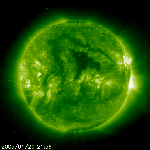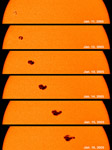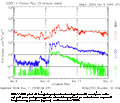WEEKLY UPDATE FOR 21 JANUARY 2005:
GRAVITY PROBE B MISSION STATUS AT A GLANCE
| Item | Current Status |
| Mission Elapsed Time: | 276 days (39 weeks/9 months) |
| Current Orbit # | 4,075 as of 4:30PM PST |
| Spacecraft General Health | Good |
| Roll Rate | Normal at 0.7742 rpm (77.5 seconds per revolution) |
| Gyro Suspension System (GSS) | All 4 gyros digitally suspended in science mode |
| Dewar Temperature | 1.82 kelvin, holding steady |
| Global Positioning System (GPS) lock | Greater than 96% |
| Attitude & Translation Control (ATC) | See Mission Director’s Summary |
| Command & Data Handling (CDH) | See Mission Director’s Summary |
| Telescope Readout (TRE) | See Mission Director’s Summary |
| SQUID Readouts (SRE) | See Mission Director’s Summary |
| Gyro #1 rotor potential | -4.4 mV (before solar flare), -3.8 mV (after solar flare) |
| Gyro #2 rotor potential | 6.0 mV (before solar flare), 6.6 mV (after solar flare) |
| Gyro #4 rotor potential | -10.7 mV (before solar flare), -9.5 mV (after solar flare) |
| Gyro #3 Drag-free Status | Backup Drag-free mode (normal) |
MISION DIRECTOR'S SUMMARY
 We are in the process of recovering from the effects of 7 major solar flares that have erupted from the Sun’s surface since 15 January 2005. These flares have resulted in extremely high levels of proton radiation and two multi-bit errors (MBE) in our SRE electronics. In addition, these high levels of solar radiation saturated the GP-B telescope detectors, causing the telescope to lose track of the guide star (IM Pegasi). We have now re-locked the telescope onto the guide star. We have determined that one of the MBEs in the SRE electronics is in a non-critical location, but the second one is in a location that is used for SQUID calibration. We are in the process of creating a work-around for the second MBE location. Our science team reports that the loss of data from these events has been minimal, and that it will have no significant effect on the experimental results.
We are in the process of recovering from the effects of 7 major solar flares that have erupted from the Sun’s surface since 15 January 2005. These flares have resulted in extremely high levels of proton radiation and two multi-bit errors (MBE) in our SRE electronics. In addition, these high levels of solar radiation saturated the GP-B telescope detectors, causing the telescope to lose track of the guide star (IM Pegasi). We have now re-locked the telescope onto the guide star. We have determined that one of the MBEs in the SRE electronics is in a non-critical location, but the second one is in a location that is used for SQUID calibration. We are in the process of creating a work-around for the second MBE location. Our science team reports that the loss of data from these events has been minimal, and that it will have no significant effect on the experimental results.
MISSION NEWS
Yesterday, the National Oceanic & Atmospheric Administration’s (NOAA) Space Environment Center (SEC) issued the following advisory bulletin:
 STRONG SOLAR FLARE AND RADIATION STORM
STRONG SOLAR FLARE AND RADIATION STORM
Active solar Region 720 produced a powerful X7 flare (R3 radio blackout) today at 0701 UTC (00:01 A.M. MST). This is the largest of seven major flares observed in this large and complex sunspot cluster since it emerged as a major flare producer on 15 January.
A strong (S3) radiation storm began soon after this flare. Radiation storms on the NOAA scale are based on proton measurements at >10 MeV. However, this radiation storm is particularly interesting because of the influx of high energy protons (>100 MeV). In fact, this radiation storm, based on the >100 MeV protons, is the strongest since October 1989. A rare, strong ground-level event (GLE) was also observed. GLEs are increases in the ground-level neutrons detected by neutron monitors and are generally associated with very high energy protons (>500 MeV). Elevated neutrons at ground level means there are high fluxes of energetic protons near Earth. High energy radiation storms can be particularly hazardous to spacecraft, and to communication, navigation, and aviation operations at high latitudes.


The 7-day graph of proton activity, displayed to the right, in the lefthand chart, clearly shows the very large increase in proton radiation that has been detected over the past few days, as a result of this solar flare and the subsequent radiation storm. In particular, notice the huge increase in high-energy protons (>100 MeV), represented by the green line in the graph on 20 January 2005. This level of high-energy protons is almost 100 times greater than the high-energy bombardment that accompanied the solar storm of 7 November 2004 (shown for comparison in the righthand chart.)
This extraordinarily high level of proton bombardment saturated the GP-B telescope detectors, causing the telescope to become unlocked from the guide star. Also notable was a huge increase in single-bit errors (SBE)-81 in a 24-hour period, where the norm is around 9 SBEs per day. (SBEs are self-correcting; MBEs must be corrected by re-loading the affected memory location.) This is the first time that we can confirm an obvious correlation between solar activity and SbEs and MBEs in various electronic systems on-board the GP-B spacecraft. Moreover, NASA reports that other satellites were also affected by this event. As was the case last November, these solar flares triggered a severe geomagnetic storm here on Earth, and Norway has reported seeing a beautiful Aurora. As of today, the solar activity is continuing, but the levels of proton bombardment appear to be decreasing. The GP-B telescope is now re-locked on the guide star, and the Attitude and Translation Control System (ATC) is once again performing nominally. Performance of the SRE electronics appears to be unaffected by the two MBEs sustained in its memory locations, and we are continuing to keep a watch on it. The net effect of this event on the experimental results appears to be negligible-although, it did keep a number of GP-B staff members very busy this past week.Our science team takes the Level 1 data, filters it, factors in ephemeris information, and other interesting daily information (solar activity, etc). The science team also performs several important “pre-processing” steps on the data that will be described in a future highlight. Once that initial science process is complete, that data is stored in the “Level 2” database. From there, more sophisticated analysis can be performed. For more information about this past week’s solar storm, see the following Web sites:
- National Weather Center Space Environment Web site
- NASA/ESA SOHO—Exploring the Sun--Web site
- NASA Sun-Earth Real-time Viewer
- NASA Exploring the Universe—Our Solar System, 19 January 2005 News
PHOTO OF GP-B IN ORBIT FROM AMATEUR ASTRONOMER STEFANO SPOSETTI

Just before the holidays, Swiss amateur astronomer and physics teacher, Stefano Sposetti sent us two new photos of the GP-B spacecraft in orbit, one of which is shown to the right. In this photo, taken on 6 December 2004 (during the spacecraft’s full-sun season), Mr. Sposetti used a 20mm f2.8 photo lens, coupled with a CCD camera on a fixed tripod, with a 60-second exposure to capture a beautiful time exposure of the GP-B spacecraft, rising over a rooftop. You can view other astronomical photos taken by Mr. Sposetti, including photos of the GP-B spacecraft on Mr. Sposetti’s Web page in the Astronomical Image Data Archive (AIDA). As always, we are most grateful to Mr. Sposetti for sending us this extraordinary photo.
THE EINSTEIN EXHIBITION AT THE SKIRBALL CULTRAL CENTER IN LOS ANGELES
 If you're going to be in Los Angeles anytime before 30 May 2005, and if you’re interested in Einstein’s life and work, the Einstein Exhibition at the Skirball Cultural Center (just north of the Getty Museum on Interstate 405) is the most comprehensive presentation ever mounted on the life and theories of Albert Einstein (1879-1955). It explores his legacy not only as a scientific genius who re-configured our concepts of space and time, but also as a complex man engaged in the social and political issues of his era. It examines the phenomenon of his fame and his enduring status as a global icon whose likeness has become virtually synonymous with genius.
If you're going to be in Los Angeles anytime before 30 May 2005, and if you’re interested in Einstein’s life and work, the Einstein Exhibition at the Skirball Cultural Center (just north of the Getty Museum on Interstate 405) is the most comprehensive presentation ever mounted on the life and theories of Albert Einstein (1879-1955). It explores his legacy not only as a scientific genius who re-configured our concepts of space and time, but also as a complex man engaged in the social and political issues of his era. It examines the phenomenon of his fame and his enduring status as a global icon whose likeness has become virtually synonymous with genius.
In this exhibit, you can examine Einstein's report card, inspect his FBI file, and enjoy his family photographs, love letters, and diary entries. Exhibition highlights include scientific manuscripts and original correspondence—including original handwritten pages from the 1912 manuscripts of the special theory of relativity and his 1939 letter to President Roosevelt about nuclear power—and a wealth of other documents from the Albert Einstein Archives at the Hebrew University of Jerusalem.



In addition to these displays of Einstein memorabilia, the exhibit also features a number of interactive components that help provide an understanding of Einstein's revolutionary theories. Furthermore, several “explainers,” identified by their red aprons, are on hand to discuss various aspects of the exhibit and to explain and demonstrate difficult concepts, such as time dilation and warped spacetime. At the end of the exhibit, you’ll find one of GP-B’s gyro rotors on display.
The Einstein exhibition was jointly organized by the American Museum of Natural History (AMNH), the Hebrew University of Jerusalem, and the Skirball Cultural Center. It was designed by the AMNH under the supervision of Dr. Michael Shara, curator of the exhibit and chairman of the museum’s Astrophysics Department. It opened in November 2002 at the AMNH in New York and then traveled to Chicago and Boston, spending about 8 months in each location. It will remain at its final U.S. stop at the Skirball Center in Los Angeles through 29 May 2005, after which time it will move permanently to the Hebrew University in Jerusalem.
Information about the Einstein exhibition is available on the Skirball Center Web site. If you can’t make it to Los Angeles, you can visit the AMNH’s virtual Einstein exhibit on the Web.
Photos and charts: GP-B Public Affiars Coordinator, Bob Kahn, created the composite photo of the GP-B spacecraft in orbit. The photos of solar flares and sun spots were taken from the NASA/ESA SOHO Web site. The charts showing the elevated levels of proton activity are from the NOAA Web site. The photos from the Einstein Exhibit are courtesy of the Skirball Cultural Center. Click on the thumbnails to view these images at full size.
MORE LINKS ON RECENT TOPICS
- Track the satellite in the sky
- Photo, video & and news links
- Build a paper model of the GP-B Spacecraft
- Following the mission online
- Our mailing list - receive the weekly highlights via email
- The GP-B Launch Companion in Adobe Acrobat PDF format. Please note: this file is 1.6 MB, so it may take awhile to download if you have a slow Internet connection.
Previous Highlight
Index of Highlights
